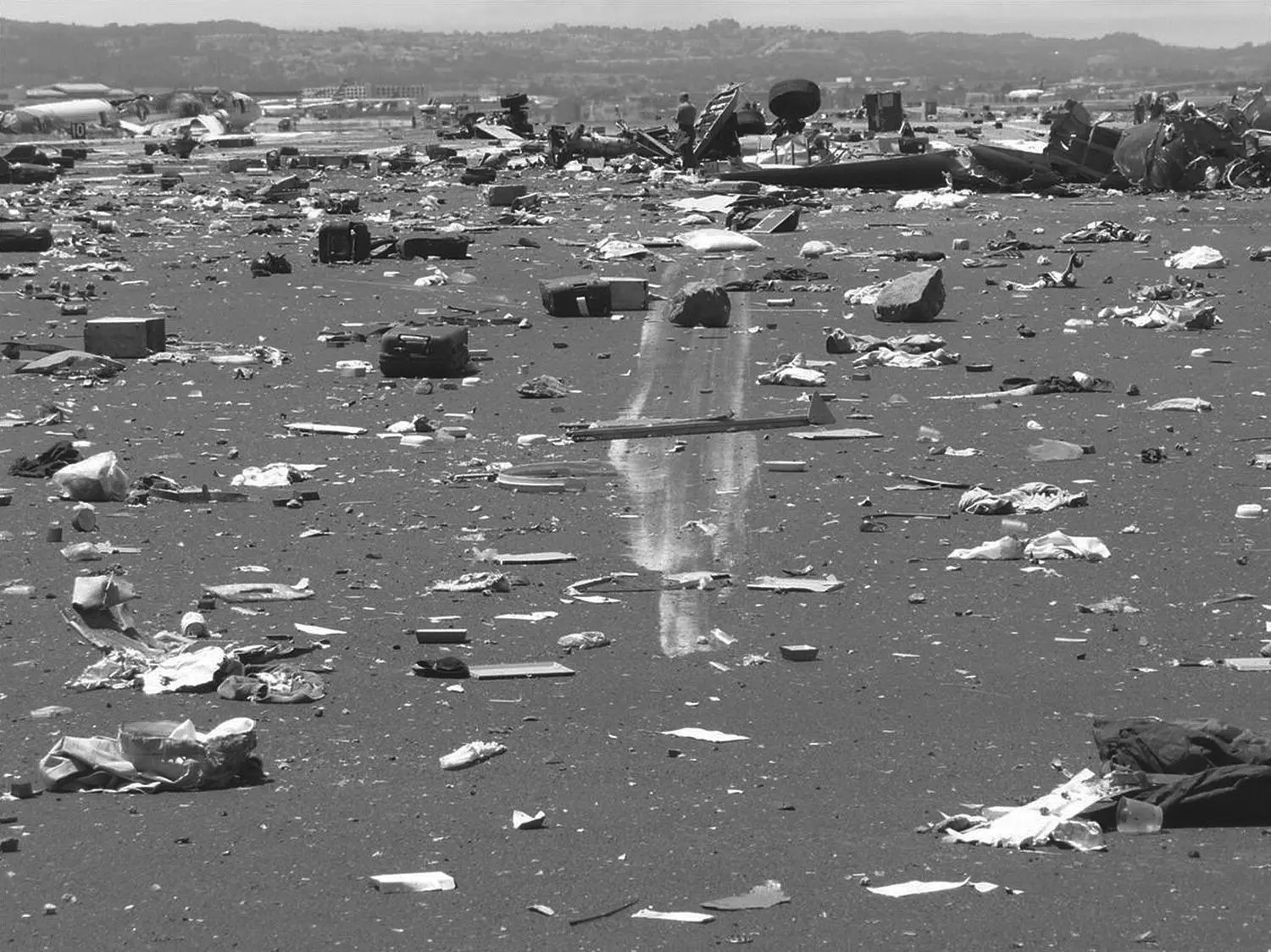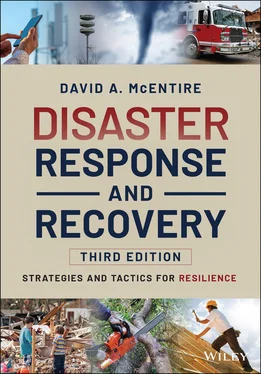David A. McEntire - Disaster Response and Recovery
Здесь есть возможность читать онлайн «David A. McEntire - Disaster Response and Recovery» — ознакомительный отрывок электронной книги совершенно бесплатно, а после прочтения отрывка купить полную версию. В некоторых случаях можно слушать аудио, скачать через торрент в формате fb2 и присутствует краткое содержание. Жанр: unrecognised, на английском языке. Описание произведения, (предисловие) а так же отзывы посетителей доступны на портале библиотеки ЛибКат.
- Название:Disaster Response and Recovery
- Автор:
- Жанр:
- Год:неизвестен
- ISBN:нет данных
- Рейтинг книги:5 / 5. Голосов: 1
-
Избранное:Добавить в избранное
- Отзывы:
-
Ваша оценка:
- 100
- 1
- 2
- 3
- 4
- 5
Disaster Response and Recovery: краткое содержание, описание и аннотация
Предлагаем к чтению аннотацию, описание, краткое содержание или предисловие (зависит от того, что написал сам автор книги «Disaster Response and Recovery»). Если вы не нашли необходимую информацию о книге — напишите в комментариях, мы постараемся отыскать её.
The new edition of the standard textbook in the field, updated with new studies and practical guidelines for reacting to the complexities of today’s disasters Disaster Response and Recovery: Strategies and Tactics for Resilience
Disaster Response and Recovery: Strategies and Tactics for Resilience, Third Edition
Disaster Response and Recovery — читать онлайн ознакомительный отрывок
Ниже представлен текст книги, разбитый по страницам. Система сохранения места последней прочитанной страницы, позволяет с удобством читать онлайн бесплатно книгу «Disaster Response and Recovery», без необходимости каждый раз заново искать на чём Вы остановились. Поставьте закладку, и сможете в любой момент перейти на страницу, на которой закончили чтение.
Интервал:
Закладка:
Instances of cruise ships and ferries sinking, vessels crashing into docks, or oil tankers hitting jagged rocks and puncturing their hulls are transportation hazards that have occurred in the past and in more recent years too. Almost everyone is aware of the sinking of the Titanic, which killed over 1500 people in 1912. The event illustrated the impact of careless navigation, the danger posed by icebergs, and the need for a sufficient number of lifeboats on ships. Unfortunately, there continue to be many other examples of shipping accidents at sea.
On December 6, 1917, two ships – the Mont‐Blanc and the SS Imo collided in the Halifax Harbor in Canada. Barrels of benzol on the Mont‐Blanc caught fire and TNT in the hull soon exploded. The resulting blast was devastating, destroying many nearby buildings and killing about 2,000 people. It required a massive international relief effort on the part of the Canadian and U.S. governments.
In January of 2012, the captain of the Costa Concordia deviated from the designated route in the Mediterranean Sea and struck rocks. The Italian cruise liner sunk and 32 people died as a result. The sinking of ferries is also common in places like India or the Philippines, where they are often overloaded with people and supplies. On other occasions, captains have lost control of ships in harbors in New York and Canada. One of the most notorious incidents was the 2003 Staten Island Ferry crash. The vessel ran into a concrete pier, killing 11 people and injuring over 70. In some cases, extreme environmental damage may result from shipping accidents. The most notable transportation‐related oil spill in U.S. history occurred on March 24, 1989, in Prince William Sound, Alaska. When the Exxon Valdez ran aground, more than 240,000 barrels of oil were deposited into the seawater, polluting the beach and killing thousands of animals.
For Example
Ferry Sinking in Bangladesh
In July 2003, a ferry traveling to the southeast from the capital of Dhaka sank. The vessel encountered turbulent waters where two rivers merge. The boat, carrying between 500 and 800 people, capsized and quickly took on water. About half of those on the ship were rescued by fishermen or managed to swim to shore about 75 yards away. The overcrowded ferry and strong currents produced one of the deadliest transportation disasters in Bangladesh ever.

Wreckage from the Asiana Airlines Boeing 777 that crashed on July 6, 2013 while landing at San Francisco International Airport.
Airplane crashes are surprisingly less frequent than most other types of transportation accidents, but they may happen when wind shear occurs, when runways are icy or wet, when planes are not meticulously engineered and maintained, and when pilots overshoot or undershoot runways. Regardless of the cause, plane crashes can be particularly lethal. In certain cases, all passengers onboard will be killed. In November 2001, an Airbus A300‐600 broke apart over Queens, New York, due to problems associated with the stress placed on the vertical stabilizer. Each of the 260 passengers and crewmembers died, and much of the fuselage landed in a neighborhood, which only
added to the adverse consequences. In other cases, passengers may be fortunate to survive plane crashes. A Boeing 777 originating from South Korea crashed on July 6, 2013, at the San Francisco International Airport when it hit the seawall just short of the runway. The pilot was not sufficiently trained on the aircraft he was flying, and the guidance system was disabled at the airport at the time. While there were only 3 fatalities, nearly 200 people were injured. It is certainly amazing the outcome was not more severe. On different occasions, two Boeing 737 Max aircraft experienced fatal accidents due to software issues. Lion Air Flight 610 and Ethiopian Airlines Flight 302 crashed in 2018 and 2019, respectively. These air disasters resulted when incorrect data from a sensor forced the nose of the aircraft down; 346 passengers and crew were killed, and this resulted in the grounding of such aircraft for many airlines around the world until the software could be fixed in November 2020.
For Example
The Space Shuttle Columbia
Although the break‐up of the Space Shuttle Columbia is not considered a disaster, it was definitely a crisis situation that required the involvement of many personnel including emergency managers. During the launch, a piece or pieces of the foam insulation broke off the external tank and hit the left wing of the space shuttle. Upon re‐entry into the earth’s atmosphere on February 1, 2003, hot gasses damaged the heat shield further and caused the shuttle to become unstable. Due to extreme forces, the space craft broke apart and debris was scattered from Fort Worth, Texas, to the western portions of Louisiana. As the recovery operation began, information about what had occurred was shared with the public. The 2,000+ debris fields had to be protected from people who might have been curious about the pieces from space shuttle. The debris and bodies of the astronauts had to be collected for investigation. These and other activities required the involvement of NASA, state officials, fire fighters, police officers, amateur radio operators, and many other volunteers. Emergency managers helped to coordinate many of the recovery efforts.
Self‐Check
What is a technological hazard?
What are the types of technological hazards?
Why do technological hazards occur?
How does industry and commerce influence hazards?
What can be done to better prevent or deal with technological disasters?
1.4 Civil/Conflict Hazards
There are several types of civil/conflict hazards,which suggests competitive behavior or violent acts between individuals and groups of people. Panic flight, mass shootings, riots, terrorism and war fall into this category. Each will be discussed in the following section.
1.4.1 Panic Flight
Panic flight, or the fleeing of many individuals from what appears to be imminent harm, is extremely rare. However, when panic flight does occur, it has resulted in death and injuries under certain situations. Panic flight is most likely to occur when large crowds gather at concerts, sporting venues and other large public gatherings. An example took place on February 20, 2003, in West Warwick, Rhode Island. The rock band Great White was performing at a nightclub in this city. The road manager used pyrotechnics inside the building, causing the ceiling to catch on fire. As the fire spread quickly, occupants headed for the doors. Because most people exited the same way they entered the building, a bottleneck ensued, and many were trampled or became stuck. Around 100 people died in the blaze and over 180 were injured. The tragedy consequently prompted a review of fire exits and sprinkler systems around the nation. Such events have occurred elsewhere around the world.
For Example
Stampedes and Crowd Crushes
Concerts may result in serious emergency situations. In 2013, a fire broke at the Kiss nightclub in Santa Maria, Brazil, when a flare was lit on stage. More than 200 people died during the panicked evacuation. Another 150 were injured while leaving the burning nightclub. In 2021, more than 50,000 people attended the Astroworld festival in Houston where Travis Scott was performing. Nine individuals died and another 300 people were injured when the crowd compressed toward the stage. These events illustrate the dangers of panic flight, overcapacity, and the lack of signage and security personnel.
Читать дальшеИнтервал:
Закладка:
Похожие книги на «Disaster Response and Recovery»
Представляем Вашему вниманию похожие книги на «Disaster Response and Recovery» списком для выбора. Мы отобрали схожую по названию и смыслу литературу в надежде предоставить читателям больше вариантов отыскать новые, интересные, ещё непрочитанные произведения.
Обсуждение, отзывы о книге «Disaster Response and Recovery» и просто собственные мнения читателей. Оставьте ваши комментарии, напишите, что Вы думаете о произведении, его смысле или главных героях. Укажите что конкретно понравилось, а что нет, и почему Вы так считаете.












